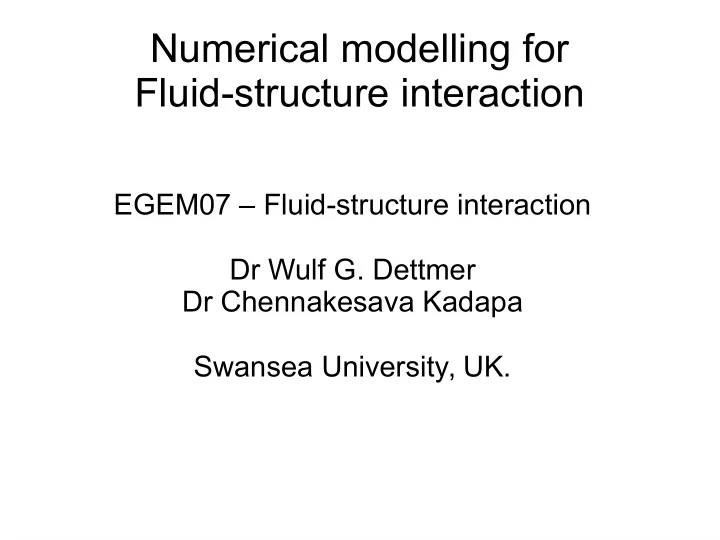

Numerical modelling for Fluid-structure interaction EGEM07 – Fluid-structure interaction Dr Wulf G. Dettmer Dr Chennakesava Kadapa Swansea University, UK.
Table of contents (1)Introduction (2)Aspects of numerical modelling for FSI (3)Body-fitted Vs Unfitted/immersed methods (4)Monolithic Vs Staggered schemes (5)A stabilised immersed framework for FSI
Introduction to FSI Interactions of fluid and solid A multi-physics phenomenon Abundant in nature – Almost every life form Occurs in many areas of engineering – Aerospace: Aircraft, parachutes, rockets – Civil: Bridges, dams, cable/roof structures – Mechanical: Automobiles, turbines, pumps – Naval: Ships, off-shore structures, submarines
Governing equations Fluid: (Eulerian) Solid: (Lagrangian) Interface: Kinematic condition: Equilibrium condition:
Aspects of numerical modelling Solid Fluid solver solver Coupling Can we solve all the FSI problems if we use the best available solvers for fluid and solid sub-problems?
Aspects of numerical modelling Solid Fluid solver solver Coupling Can we solve all the FSI problems if we use the best available solvers for fluid and solid sub-problems? No. But, why?
Aspects of numerical modelling Solid Fluid solver solver Coupling Can we solve all the FSI problems if we use the best available solvers for fluid and solid sub-problems? No. But, why? The devil is at the interface.
Caution! If someone tells you that his/her scheme/tool can solve a FSI problem without actually looking at the problem, then it is highly likely that he/she is lying .
Important properties of numerical schemes for FSI (1) Existence Does the tool have FSI capability? (2) Robustness For a reasonable time step, does the scheme work without crashing? (3) Accuracy How accurate is the solution? (4) Efficiency What is the amount of time required?
Body-fitted meshes Meshes aligned with the solid boundary Finite Element or Finite Volume schemes for the fluid problem How to deal with moving solids?
Body-fitted meshes When the solid moves Surrounding fluid mesh also moves Arbitrary Lagrangian-Eulerian (ALE) formulation for the fluid For small displacements mesh deformation schemes For large displacements re-meshing techniques
Body-fitted meshes Advantages Efficient and accurate for simple problems Well established Available in commercial software Disadvantages Mesh generation is cumbersome Require sophisticated re-meshing algorithms Complicated and inefficient in 3D Difficulty in capturing topological changes
Unfitted/immersed methods ● Solids immersed/embedded on fixed grids Advantages No need for body-fitted meshes No need for re-meshing Ideal for multi-phase flows, fracture Complex FSI problems can be solved Disadvantages Needs to develop a fluid solver Majority of the schemes are only 1 st order accurate in time Very limited availability in commercial software
Integration in time Only implicit schemes are considered Fluid: 1 st order - Backward Euler 2nd order – Crank-Nicolson/Trapezoidal, Generalised-alpha, BDF2 Solid: 1 st order - Backward Euler 2 nd order - Crank-Nicolson/Trapezoidal, Generalised-alpha
✔ Spatial discretisation ✔ Temporal discretisation Coupling strategies Monolithic Vs Staggered
Governing equations Fluid: (Eulerian) Solid: (Lagrangian) Interface: Kinematic condition: Equilibrium condition:
Coupling Data transfer between fluid and solid Types of techniques Dirichlet-Neumann (body-fitted, unfitted) Robin-Robin (body-fitted, unfitted) Body-force (standard Immersed methods) We consider Dirichlet-Neumann The most intuitive and physical Velocity boundary condition on the Fluid Force boundary condition on the Solid
Monolithic schemes • Fixed-point or Newton-Raphson • Advantages ➔ No added-mass instabilities ➔ 2 nd order accuracy in time is possible • Disadvantages ➔ Need to develop customised solvers ➔ Computationally expensive ➔ Difficult to linearise ➔ Convergence issues
Staggered schemes • Solve solid and fluid separately • Advantages ➔ Computationally appealing ➔ Existing solvers can be used ● Disadvantages ➔ Added-mass instabilities ➔ Difficult to get 2 nd order accurate schemes for FSI with flexible structures in the presence of significant added-mass ➔ Efficiency and accuracy decrease with the increase in added mas
Summary of FSI schemes Staggered Monolithic Efficient Commerical software Easiest of all Body-fitted No added-mass issue Added-mass issues Expensive No added-mass issue Efficient Complicated Relatively easy Unfitted Expensive Many applications Added-mass issue
What is added mass issue? Instability arising when 1) The density of the solid is close to or less than that of the fluid Blood flow through arteries 2) When the structure is very thin Shell structures 3) When the structure is highly flexible Roof membranes, parachutes
A model problem for FSI d d Dettmer, W. G. and Peric, D. A new staggered scheme for fluid-structure interaction , IJNME, 93, 1-22, 2013.
A stabilised immersed framework for FSI Combines the state-of-the-art Hierarchical b-splines SUPG/PSPG stabilisation for the fluid Ghost-penalty stabilisation for cut-cells Solid-Solid contact Staggered solution schemes Wide variety of applications
B-Splines and hierarchical refinement - spatial discretisations for unfitted meshes
B-Splines
Hierarchical B-Splines
Hierarchical B-Splines
Hierarchical B-Splines
B-Splines • Nice mathematical properties • Tensor product nature • Partition of unity • Higher-order continuities across element boundaries • Always positive • No hanging nodes • Ease of localised refinements • Efficient programming techniques and data structures
Sample meshes
Formulation Incompressible Navier-Stokes Variational formulation Time integration: Backward Euler (O(dt)) and Generalised-alpha (O(dt^2))
Transverse Galloping
Rotational Galloping
Sedimentation of multiple particles
Model turbines
Ball check valve
Relief valve in 3D
References (1) W. G. Dettmer and D. Perić. A new staggered scheme for fluid-structure interaction , IJNME, 93, 1-22, 2013. (2) W. G. Dettmer, C. Kadapa, D. Perić, A stabilised immersed boundary method on hierarchical b-spline grids, CMAME, Vol. 311, pp. 415-437, 2016. (3) C. Kadapa, W. G. Dettmer, D. Perić, A stabilised immersed boundary method on hierarchical b-spline grids for fluid-rigid body interaction with solid-solid contact, CMAME, Vol. 318, pp. 242-269, 2017. (4) Y. Bazilevs, K. Takizawa, T. E. Tezduyar, Computational Fluid-Structure Interaction: Methods and Applications , Wiley, 2013.
Recommend
More recommend